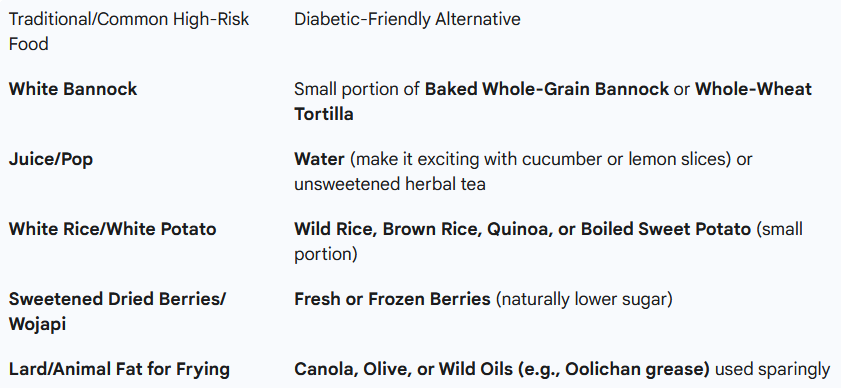 Frequently Asked Questions About IndigiHealth Foods
Frequently Asked Questions About IndigiHealth Foods


This list of FAQs is designed for a website aimed at supporting First Nations, Inuit, and Métis communities in Canada to make healthy food choices that respect culture, budget, and health needs with options for diabetes management.
1. Traditional Foods & Culture
Q1. How do traditional foods fit into a modern, healthy diet like Canada's Food Guide? A. Traditional foods are often the best choices! They naturally align with the Food Guide's principles:
- Protein Foods: Wild game (moose, bison, caribou), fish (salmon, trout), and seafood are lean and rich in nutrients like Omega-3 fats.
- Vegetables & Fruit: Wild berries, roots, and foraged greens (fiddleheads, wild onions) are local, nutrient-dense fruits and vegetables.
- Grains/Starches: Foods like wild rice are whole grains with superior nutritional profiles.
Q2. Are traditional methods like making and eating bannock healthy? A. Traditional bannock, often made with refined white flour and pan-fried, is high in simple carbohydrates and fat, which can affect blood sugar and overall health.
- Healthier Alternative: Try making bannock with whole-grain flour (like whole-wheat or oatmeal flour) and baking it (oven-baked, "No-Fry" bannock) instead of frying it. Keep the portion size small, as it is a starchy grain.
Q3. Is it safe to eat traditional foods like wild game and fish due to environmental concerns? A. For many, traditional foods remain a valuable and nutritious part of the diet. However, it is a valid concern. We recommend you:
- Consult Local Resources: Check with your local community health authority, environmental groups, or Elders for information on contaminants (like mercury in some fish) specific to your region.
- Vary Your Diet: Eating a variety of foods from different sources helps reduce the chance of over-consuming a specific contaminant.
2. Budget-Friendly Healthy Eating
Q4. Healthy food is expensive, especially in the North and in remote communities. What are the best budget-friendly staples? A. Eating healthy on a budget is challenging, but possible by focusing on affordable, non-perishable staples:
- Plant Protein: Dry beans, lentils, and canned beans (rinse well to reduce sodium) are the most affordable protein and fiber sources.
- Whole Grains: Rolled oats (oatmeal), brown rice, and barley are very cost-effective when bought in bulk.
- Vegetables: Buy frozen vegetables (mixed bags, peas, corn, broccoli) as they are often cheaper, just as nutritious, and have zero waste. Canned vegetables (look for "low sodium") and canned fish (tuna, salmon) are also good options.
Q5. How can I make meat stretch further in a meal to save money? A. You can "stretch" expensive protein by combining it with cheaper, high-fiber plant proteins:
- Blend: Mix cooked lentils or beans with ground meat (like lean ground beef, turkey, or game) in recipes like chili, taco filling, or stews.
- Prioritize Plants: Make beans or lentils the main ingredient for dinner several nights a week (e.g., lentil soup, three sisters chili).
- Batch Cooking: Buy family packs of lean meat on sale, divide into portions, and freeze. Cook large batches of soup or chili and freeze individual portions for easy, cheap lunches.
Q6. Are canned and frozen vegetables and fruits as healthy as fresh ones? A. Yes! Frozen and canned produce are excellent, budget-friendly options. They are often picked at their peak ripeness and flash-frozen, locking in nutrients.
- Tip: Look for frozen vegetables without added sauces, and canned goods that are labeled "no added salt" or "packed in water" (for fruit, look for "packed in juice" or "no added sugar").
3. Diabetes Management (Diabetic Alternatives)
Q7. What are the best foods to eat to manage Type 2 Diabetes? A. Focus on foods that stabilize your blood sugar (glucose) levels:
- Half a Plate of Non-Starchy Vegetables: Greens, broccoli, peppers, tomatoes. These are very low in carbohydrates.
- Low Glycemic Index (GI) Carbohydrates: These break down slowly. Choose wild rice, quinoa, barley, oats, and sweet potatoes (in moderation) over white rice, white bread, and instant potatoes.
- Lean Protein: Lean game meat, fish, chicken, eggs, beans, and lentils. Protein helps slow down sugar absorption.
Q8. What are some healthier substitutes for common high-carb or high-sugar items? A. Small swaps make a big difference for blood sugar control:

Q9. How can I enjoy social gatherings and community feasts without negatively impacting my blood sugar? A. Food is culture and community—you don't have to miss out!
- Balance the Plate: When filling your plate, follow the recommended balance: prioritize vegetables, choose a sensible portion of protein (game/fish), and take a smaller portion of the starchy items (bannock, potatoes).
- Be Mindful of Cooking: Choose foods that are baked, roasted, or boiled over those that are deep-fried or heavily sugared.
- Start with Protein: Eating your protein and vegetables first can help slow down the absorption of carbohydrates.
4. General Healthy Eating
Q10. What is the most important change I can make today?
- Drink water. Switching from sugary drinks (pop, juice, sweetened coffee) to water is the single most effective way to cut unnecessary sugar and calories from your diet. Make water your primary drink of choice.
 Disclaimer
Disclaimer


This is not health advice. Please connect with your trusted healthcare and nutritionist/dietitian professionals before making any health or dietary changes. All of the information on IndigiHealth Foods is only meant to inspire healthy eating and returning to traditional Indigenous ways of living off the land and providing nourishment. This is meant to be a hub for resources and inspiration of where to look for trusted health advice from a professional perspective. IndigiHealth Foods is not liable for any health ailments that may be impacted by the advice shared on here. By visitng this webite and reading the information offered, you agree to not take any and all information from IndigiHealth Foods as professional health advice.